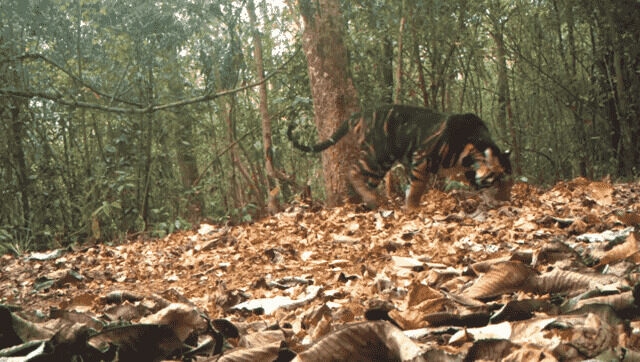The black sheep of Indian tigers, rare and majestic
The reason behind these tigers have majestic black stipes is due to mutation. These are the Bengal Tigers, with a single mutation in a gene, which causes the black stipes to enlarge and spread into the orange background

Rare Black Tiger. Twitter/@susantananda3
A rare black tiger was seen at Odisha's Simlipal National Park, where it was scratching the branch of a tree. A 15-second clip was posted on twitter by an IFS officer Susanta Nanda on the occasion of International Tigers Day. The officer is known for sharing wildlife photos on twitter as well.
In his tweet, Nanda said, "Sharing an interesting clip of a rare melanistic tiger marking its territory on international Tigers day".
Tigers are symbol of sustainability of India’s forests…
Sharing an interesting clip of a rare melanistic tiger marking its territory on international Tigers day.
From a Tiger Reserve poised for recovery of an isolated source popuation with a very unique gene pool. Kudos🙏🙏 pic.twitter.com/FiCIuO8Qj4— Susanta Nanda IFS (@susantananda3) July 29, 2022
Praveen Kaswan, an IFS officer, retweeted the clip and shared some extra information about this rare species. He said, "The rare tigers were first officially discovered in STR (Similipal Tiger Reserve) in 2007."
The black tigers of #India. Do you know there are pseudo- melanistic tigers found in Simlipal. They are due to genetic mutation & highly rare. @susantananda3 pic.twitter.com/oEMCqRYKiF — Parveen Kaswan, IFS (@ParveenKaswan) July 30, 2022
According to NDTV, the black or pseudo-melanistic tigers have distinctive dark stripe pattern on a light background of white or golden. They are rare and have only been camera-trapped in Similipal till date.
The reason behind these tigers having majestic black stipes is due to mutation. These are the Bengal Tigers, with a single mutation in a gene, which causes the black stipes to enlarge and spread into the orange background.
According to Indian Express, a cub gets two copies of each gene from both parents, and a recessive gene can show up only in the absence of the dominant one. So, two normal-pattern tigers carrying the recessive pseudo-melanism gene will have to breed together for a one-in-four probability of giving birth to a black cub.
Scientists believe that these tigers are inbred and come from a small founding population. They are mostly found in eastern parts of India. The population of these tigers is vulnerable to extinction even over a short period of time.
With input from agencies
Read all the Latest News, Trending News, Cricket News, Bollywood News,
India News and Entertainment News here. Follow us on Facebook, Twitter and Instagram.
also read

Power of evolution: Scientists are trying to answer why and how did our ancestors lose their tails
Researchers have identified more than 30 genes involved in the development of tails in various species, from an iguana’s long whip to the stub on a Manx cat.

After CCR5 gene, scientists find second, rare gene mutation that protects against HIV
It was identified among members of a family in Spain who suffered from type 1F limb-girdle muscular dystrophy.

Breast cancer gene mutation may hamper fertility, finds new study
Women with a specific gene mutation that is known to increase the breast cancer risk may also have fewer eggs in their ovaries